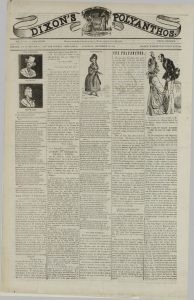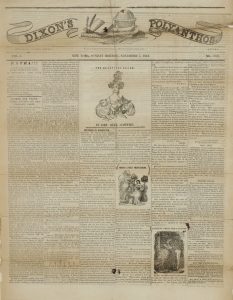Flash newspapers were a type of “underground newspaper” that catered to people interested in reading about, or participating in, illicit activities, such as gambling, prostitution, and other forms of vice. Flash newspapers were often published and circulated secretly, so as to avoid detection by law-enforcement, and consequently these newspapers were rarely collected by libraries. The best collection of flash newspapers in the United States is held by the American Antiquarian Society, and a large portion of that collection has now been digitized by Readex. The University of Illinois Library is pleased to announce that we have acquired this digital collection, American Underworld: The Flash Press.
This digital collection is special not just because the newspapers in it are so rare, but also because Readex digitized the newspapers from original print copies (in most cases), and digitized in full-color, both of which are actually uncommon in newspaper digitization. The full-color digitization furthermore makes this collection a case in which the surrogate is actually better than what scholars, for years, have been using at the American Antiquarian Society itself, since the American Antiquarian Society does not permit consultation of original print copies from this particular collection. For years their policy has been to serve (gray-scale) microfilm copies instead. The full-color digitized copies will therefore be especially exciting for researchers. Unfortunately, not all the newspapers have been digitized in color. The National Police Gazette, for example, is presented in black and white–it looks as though Readex simply recycled the version they already published in Early American Newspapers: Series 10.
The flash press was, in some sense, an extension of the penny press, which began to flourish in the 1830s. Flash newspapers are penny papers taken to a whole new level, especially in the way they used crime reporting and moral crusading, which are journalistic genres and conventions developed and perfected by the penny press. And, like the penny papers (though, again, to an exaggerated degree), the flash press was characterized by a spirit of misrule. For example, many editors of flash papers used moral crusades as pretexts for publishing reports of urban fleshpots in lascivious detail. This spirit of misrule is even evident in bibliographic features, such as apparently deliberate attempts to punk publishing conventions like newspaper numbering, a practice which, almost two hundred years later, proves to be rather vexing for librarians, who use a newspaper’s date of publication and its issue numbering to verify publication frequency and completeness of holdings. With many flash newspapers, however, publication frequency and completeness of holdings are difficult to verify, a result in part of what appear to be shenanigans practiced upon the public by printers. See, for example, these three issues of Dixon’s Polyanthos:
The first issue we have, from September 18, 1841, is “volume 1, number 3”. If this newspaper were a weekly, we would expect the next extant issue to be “volume 1, number 6.” Instead, the issue number seems to have been left blank:

The next extant issue, again if this were a weekly, should be “volume 1, number 10,” but instead it’s “volume 4, number 1,922”:

Even allowing for the possibility that Dixon used a parallel numbering scheme for his extra editions, this issue number seems to suggest that the paper was at least 35 years old, whereas it did not not actually begin publication until some time after 1838, or roughly four years prior to issue number 1,922! It’s also worth noting that between the October and November numbers, the newspaper switched format, from a small, four-column sheet to a much larger, six-column sheet. The format change likely indicates the use of a different printing press, possibly a new one (unfortunately we have no later issues with which to compare it).
Another example of such misrule is in the practice of concealing the identity of the publisher, and even the place of publication. This form of caginess actually served a very practical function since much of what the flash newspapers printed was libelous and obscene. Publishers of flash newspapers were not infrequently sued for libel and obscenity, but the publisher obviously could not be sued if authorities were unable not identify him, or even locate the place from which he was publishing his newspaper. An example of such a newspaper is the Libertine: in the one issue we have, neither the name of the publisher nor the place of publication is given in any of the usual places (nameplate, masthead, or bottom of last page):

In the above example, the publisher describes his newspaper, and states when it will be published and how much a subscription will cost, but rather oddly fails to specify how interested parties can go about obtaining a subscription! Very likely many of these newspapers were sold on the street, another innovation of the penny press borrowed by the flash newspapers.
I do have one complaint about this new collection: the image resolution is really too low for the type of document being rendered–the larger page size, compactly set type, and often faded or dirty sheets mean the user often needs to magnify the page images in order to make the text legible. In many cases, the image resolution is simply too low for the necessary level of magnification (see the above image for an example). The trade-off, of course, is faster delivery times: at higher resolutions, these full color images would be slower loading, and remember that even though the images don’t look like what we usually consider “full color”, the bit depth required to render a black and white page in its original “color” is just as large as the bit depth required to render images more traditionally considered “color.” A digital image might not use every available color, but the number of bites per pixel remains the same. In short, image resolution and image bit depth are a tricky needle to thread: increasing both resolution and bit depth rapidly increases the bandwidth required to deliver those files, so digital collection managers must decide on a trade-off between the two, with an increase of one necessitating a decrease of the other.
Click here to view a complete list of titles in American Underworld: The Flash Press.


